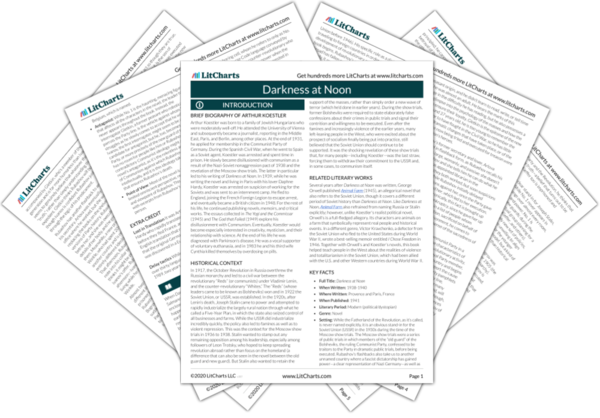In almost every room (besides the prison cells), the portrait of the Party leader No. 1 hangs from the wall. Rubashov tends to perceive the leader’s facial expression differently depending on the circumstance. Sometimes, the portrait is described as staring at people with menacing “frozen eyes.” At other times it’s an expression of knowing irony that seems to characterize No. 1’s face. Whatever the attitude or tone, though, the ubiquity of the portrait underlines the ubiquity of No. 1’s orders throughout the society. In an environment in which people are encouraged to denounce others as traitors or counter-revolutionaries, it can indeed seem like No. 1’s eyes and ears have extended everywhere, just as his portrait has been hung on every wall. Rubashov often has to pause and wonder how his interrogators have learned about trifling, off-the-cuff conversations he’s had at cocktail parties, for instance, years before. The portrait of No. 1 also serves as a reminder of the ultimate source of stability in the Fatherland: even if No. 1 claims to be no more than a representative of the people in general, all policy eventually can be traced back to his desires and beliefs. No. 1’s portrait is not the only painting or even the only portrait to be found in the novel, but what distinguishes it is that, unlike the others, it never disappears or is altered. Portraits of other Party members and leaders are surreptitiously replaced or destroyed as their fortunes rise and fall. Rather than an equal, radical Communist society, the book seems to suggest that this world is the ultimate autocracy, one in which only one person can be considered safe.
No. 1’s Portrait Quotes in Darkness at Noon
Instead of the old portraits, a light patch shone from Ivanov’s wallpaper; philosophical incendiarism had given place to a period of wholesome sterility. Revolutionary theory had frozen to a dogmatic cult, with a simplified, easily graspable catechism, and with No. 1 as the high priest celebrating the Mass.










